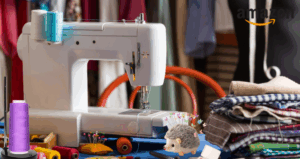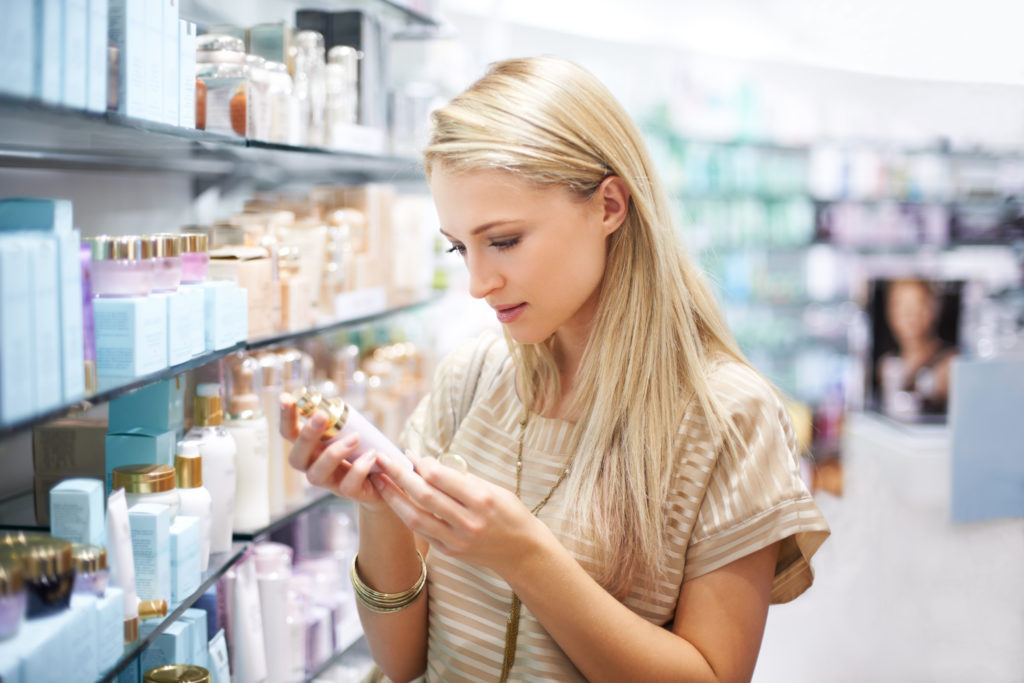Products are selected by our editors, we may earn commission from links on this page.
Any self-proclaimed makeup junkie would agree that there’s nothing like finally getting your hands on your newest beauty product obsession, especially if it was a bit of a splurge. But what if you found out that your new luxe lipstick or palette — you know, the one you just dropped half of a car payment on — was a fake?
Luxury beauty products are part of a $17 billion market and, as with any other luxury market that’s raking in the cash (i.e. designer accessories or handbags), there’s always a sketchy sub-industry of knockoffs lurking in the corner.
That’s right, counterfeit cosmetics are a major thing.
While you’ve definitely heard of counterfeit versions of high-end apparel and accessories, nobody is talking about fake beauty products. The shady business venture is a very real and dangerous to your health.
If you do a quick Google search, you will be bombarded with horror stories, which includes everything from painful rashes and chemical burns to research proving fake makeup can slowly poison your body and even cause cancer.
According to Greg Marrazzo, the Senior Vice President, Deputy General Counsel of Estée Lauder Companies, Ranker found, illegal operations don’t often take the same sanitation measures as OSHA-regulated manufactures in the US.
“If you took the most disgusting frat house bathroom, it looks like a surgical suite compared to these conditions. It’s filthy, there’s bacteria everywhere… it’s disgusting,” Marrazzo, explained to the outlet of the counterfeit factories in China.
Need more proof?
Beauty blogger Tanya Arguelles found out first hand when she purchased a popular eyeshadow from a downtown Los Angeles street market last year, according to CBS.
I just wanted to know, can this possibly be as good as the $50 that I just spent?” Arguelles told the network.
Ultimately, the vlogger tested both eye shadows and when she woke up the next morning, her eye was burning.
“Within the first 45 minutes, I realized that it was an eye infection. I couldn’t get my contacts on,” Arguelles said. “I looked back at the footage and it was on the fake side. Hundred percent.”
Beyond an uncomfortable and itchy eye infection, women and men who use these products can be exposed to serious health hazards like arsenic, mercury, and aluminum.
If for any reason you’re still willing to risk it, the Los Angeles Police Department confiscated $700,000 worth of counterfeit makeup that all tested positive bacteria and animal waste.
Counterfeit Urban Decay, MAC, Kylie lip kits, and NARS were among the products seized in the LAPD raid and found to have feces.
The big issue? The packaging is nearly identical.
Detective Rick Ishitani warned consumers on CC, “”If you’re getting something that’s 50% off, 75% off, it tells you that it’s bad.”
[fm_giphy url=”https://media.giphy.com/media/l3vR7ddLcBE7ySeIg/giphy.gif”]
The thing is, consumers are super confused.
[fm_twitter url=”https://twitter.com/Sooz_1/status/962427196290813952″]
According to the U.S. Government Accountability Office, shady cosmetics are becoming an even bigger serious problem. In a recent report, the GAO tested frequently counterfeited consumer products from a variety of online retailers, including Walmart.com, Amazon.com, Newegg, Sears Marketplace, and eBay.
[fm_twitter url=”https://twitter.com/emmamorg3/status/791418164013850624″]
YouTube is teeming with reviews of real makeup vs fake-up and videos of beauty bloggers who, after purchasing, realized that they were scammed.
[fm_twitter url=”https://twitter.com/SwearByBeauty/status/915649662174007301″]
Counterfeit cosmetics are flooding the beauty market — and it’s only getting worse. In 2014, agents from the U.S. Department of Homeland Security, the New Jersey Department of the Treasury, and the Edison police department, among other agencies, raided the headquarters of a New Jersey-based counterfeiting operation. The house was filled with fakes, including 2,000 pieces of copycat makeup labeled as premium MAC-brand cosmetics.
[fm_twitter url=”https://twitter.com/swatchmeup/status/776151684926038016″]
Not all fakes are being sold in a rundown warehouse.
[fm_twitter url=”https://twitter.com/KylieJenner/status/791516729507667968″]
According to a report published by Red Points, a global leader in online IP infringement detection and removal, there was a 40 percent increase in the detection of bogus beauty products on social media (specifically Instagram and Facebook) in the weeks leading up to Mother’s Day 2018.
Counterfeit makeup isn’t just a ripoff, it’s a health concern.
The FBI reports that its agents have found human carcinogens, aluminum, dangerous levels of bacteria, and even human urine and feces (!!!) in the products they’ve seized.
[fm_twitter url=”https://twitter.com/LAPDMarcReina/status/984657708547649537″]
“Makeup contaminated with feces is a huge concern because of the infectious matter in feces,” Dr. Amanda Hoelscher told Healthline.
“I’ve seen people get eye infections from sharing mascara with a friend who had an eye infection. That was a trusted friend. Imagine what could happen if you buy and use what you think is a new or professional product but with unknown ingredients. The results won’t be pretty.”
[fm_twitter url=”https://twitter.com/EileenEdit/status/1051514689425952768″]
Educating yourself on a few of the common indicators of counterfeit cosmetics is a great way to avoid becoming a victim.
Here is everything you need to know about identifying bootleg beauty products.
[fm_instagram url=”https://www.instagram.com/p/BhkNIi1ha2U/”]
Tip #1: If you’re unsure about a product’s authenticity, don’t buy it.
[fm_instagram url=”https://www.instagram.com/p/BIpDC9og-CD/”]
Usually, bogus beauty products will have packaging that’s slightly different than the authentic brand. (It may be a different color or the lettering on the product may be different.)
Refinery29 reported on something called the “gray market”—legal but unauthorized retailers who sell all your favorite products—real or not.
While you may be drawn to the prices falling far below normal retail, you risk expired or simply unhygienic products.
Even stores you would totally trust, like Costco, have sold counterfeit merchandise.
Yves Saint Laurent and other brands sued Costco for selling fakes, Refinery29 reported.
One way to always avoid this problem is to look to see if the store is a authorized retailer, if not (like in this case,) brands cannot guarantee the same level of legitimacy you would receive at an approved retailer.
If you look below, this woman spared a few dollars for a cheaper product and found her beauty blender to be full of bugs.
[fm_youtube url=”https://www.youtube.com/watch?time_continue=561&v=VoEVm4EL_ek”]
We’re disturbed, and so should you!
Tip #2: Don’t buy anything that’s advertised as a “limited edition.”
[fm_twitter url=”https://twitter.com/lesley_makeup/status/937768516043919365″]
If you know good and well that the authentic manufacturer doesn’t offer a limited edition of a certain product, walk away.
Fake goods are everywhere and this is one trick that sellers use to create a sense of urgency.
You missed one of Kylie’s limited edition collections or it sold out too soon, so these vendors capitalize on your desire.
Don’t fall for this trap. The victims of the fraud are creating simply replicas and you’re going to be duped and disappointed.
Unsurprisingly, Huffington Post reports it is the younger generations who end up buying counterfeits (25-34.)
Often they are purchasing these frauds on websites claiming to offer “discount,” “cheap,” or “outlet” pricing.
Basically, ONLY look at reputable websites and get off a shopping site or URL that has the words “discount” or “cheap” because they’re definitely not real.
Tip #3: The only bargain you’re going to be getting is a bacterial infection.
You know how your mom says: “If it’s too good to be true, it usually is.” Well, she’s right. Drastically low prices are a red flag.
“You may save $15 by buying a counterfeit product, but you’re not truly buying the real deal at a low price,” Dr. Janet Prystowsky, a board-certified dermatologist and founder of Livad Skin Care told Healthline. “You’re paying for feces, bacteria, and harmful chemicals wrapped in a shiny box with a brand name.”
[fm_instagram url=”https://www.instagram.com/p/BcXIHpeD5YX/”]
Some makeup consumers are actively buying the knockoffs to save money. The thing we can’t stress enough, not matter how strapped you are, it’s not just about the price.
On an episode of Life of Kylie, Kylie Jenner opened up to viewers about the “responsibility” she feels to confront and stop opportunists selling counterfeit versions of her products.
While it is definitely a monetary blow to brands to lose customers, the young mogul addressed the health concerns and sadness her clients felt after getting swindled.
While it is easy to think people are just bamboozled, some shoppers know exactly what they’re there for and are encouraging others to join them in buying counterfeits.
InStyle reported about Facebook groups that buy and review fake products claiming, “One such group on Facebook has over 60,000 members who post reviews of imitation Kylie Lip Kits (“not sticky but pretty drying”) and Too Faced palettes (“actually smells like peaches!!”), among others.”
Tip #4: Texture is important.
[fm_instagram url=”https://www.instagram.com/p/BAYGZ1BwFsj/”]
If the product is weird in consistency or the texture just doesn’t feel right, trust your gut and head in the other direction.
For example, the mascara will have a certain order (even a perfumed scent is a red flag.) You should also examine the wand, which may look different than the authentic counterpart. Fake lipsticks has some imperfections and can actually look worn.
Others will show no sign of being an imitation, but are equally as hazardous.
Tip #5: Download the Smart Consumer app by GS1.
[fm_twitter url=”https://twitter.com/CCS_IIPA/status/1149296086961442816″]
While the Smart Consumer app wasn’t designed for counterfeit cosmetic detection specifically, it’s a quick way to spot fakes.
Just download the app and scan the barcode of the product you’re curious about. (If you can’t scan the barcode, enter the info manually.)
If the product is legit, then you should be able to see its info, including the name of the manufacturer that made the product, price, manufacture date, and its FSSAI license, etc.
We’ve talked your ear off about how hard these products are to identify.
Even to the most trained eye, product ranges are so vast, it can be hard to ever be certain.
Use this to not only educate yourself, but to be an empowered consumer and avoid potential toxins.
Your beauty and skincare routine, should never come at the cost of your health.
If you feel pressured into products outside your budget, please keep in mind you can find incredible, safe products from any drug-store that works just as well and is guaranteed to look way better than a product that would give you a bacterial infection.
Tip #6: Submit a tip to the National IPR Center.
[fm_twitter url=”https://twitter.com/IPRCenter/status/1055090659332423680″]
Help others by reporting the fakes. The more information law enforcement has, the better.
You have an accountable to yourself and others get this products off the market.
Even Amazon has joined forces with a company, called Project Zero, to let brands take down counterfeit goods and listings on their own.
While we hope you’ve been equipped with all the right information to avoid being duped, it’s equally as important to us, you know how to handle a reaction, if you’re ever exposed to a fake.
Step 1:
Throw it out immediately.
If you ever react poorly to a product, never use it again. Dispose of it to prevent yourself for mistaking it for something safe or a family member. Any adverse reaction can happen again, and it’s an indicator there’s something wrong with the product.
Step 2:
Talk to a medical professional, like a dermatologist.
“It is always a good idea to contact your dermatologist if it is not getting better or is worsening,” Shari Marchbein, M.D., a board-certified dermatologist told the Sunday Edit.”
“It’s also a good idea to bring the counterfeit product to your dermatologist — they may be able to figure out the source of your reaction or infection,” she advised.
Step 3:
Seek medical attention.
We told you, these products are bad news. Feces, bacterial infections, and bugs have been reported in these products.
“In rare cases, you don’t want to wait to see a doctor. If you have a fever, chills, trouble breathing, pain, swelling, severe redness, itching, pus or open wounds where you applied the product, you should see a doctor right away,” Marchbein warns. “These can all be signs of an infection or severe reaction.”





